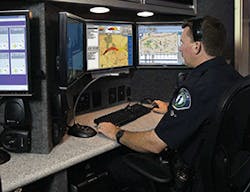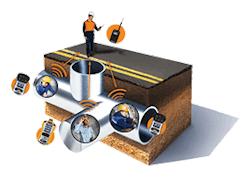Last year, two workers died from asphyxiation while repairing leaks in a manhole. In an all too frequent narrative, the second worker died after he went down to rescue the first worker.
The tragedy again exposed the need for real-time information gathering prior to confined space entry and in taking appropriate action based on an understanding of atmospheric conditions.
In 2015, OSHA passed a confined space rule that offers additional protection to construction workers. In filling what it identified as a vital gap, OSHA estimates that as many 800 construction workers a year will be protected from serious injuries. The new ruling signals that today, more than ever, regulatory bodies have the worker's back.
In step with the regulatory advances, instrumentation manufacturers are creating new wireless monitoring tools that make compliance easy, instrument operation nearly automatic and critical data accessible in real time across the enterprise.
The latest advancement in confined space monitoring is wireless gas monitoring systems that operate across multiple communication platforms. Wireless gas monitors provide the advantage of offering additional insight into atmospheric readings to more people, such as safety or plant managers who are located offsite.
Readings from the wireless monitor worn by the worker in a confined space can be relayed not only to the required attendant, but instantaneously to any part of the operation via Wi-Fi or a dedicated mesh radio network. Environmental readings from the confined space can be viewed on a laptop or smart phone with an Internet connection, and automatic emails or SMS text messages can be sent to key stakeholders who are not on the software viewing platform, ensuring rapid response to critical events.
What's more, in the event of a failure between mobile communications, the wireless monitoring system offers a greater degree of safety redundancy, or backup protection. The wireless system is protected on a secure network and may be able to switch from Wi-Fi to a dedicated mesh wireless protocol when a signal is weak. This particularly can be important to operations where work is performed remotely by a small staff or lone worker – something common in the mid-stream oil and gas industry, maritime industry, utilities and other industries.
Maritime Industry: A Special Cause for Concern
According to OSHA, the rate of confined space injury in a shipyard environment is twice that of the general construction industry. Extra care must be taken by workers, safety managers, operation personnel and emergency responders to ensure a confined space is free from substances that can be deadly.
The risk of confined space entry injury or death in marine vessels is very real. Readings from a wireless gas monitor transmitted to offsite safety managers can provide a much-needed, additional set of eyes to assess risk or mitigate an incident.
In the Pacific Northwest, an integrated tug and barge had a close call. Initial indications of a lower explosive limit did not indicate a hazard, but workers were picking up signals on their wireless photo ionization detectors (PIDs) indicating dangerous substances. As it turned out, diesel fuel from the tug had somehow migrated to a confined space in the barge. They were about to do hot work in the barge when the wireless PID detected the fuel's presence.
Fortunately, they used advanced gas detection technology to identify a potential problem that otherwise would not have been detected. The wireless PID operator's recognition and alert to the crew prevented a potential major casualty.
An industrial hygienist or other competent person usually is required by OSHA and the U.S. Coast Guard to certify a space for access and entry in a shipyard or repair facility. However, that alone does not alleviate the prevalent risks. Once that person certifies the space as safe and leaves, there's no telling what can be uncovered later.
In addition, a crew may be doing minor work in a tank or confined space during the ship's routine time in operation. Without gas detection technology or proper safety training, a deadly accident could occur.
That's what happened at a Texas repair facility when employees working an overnight shift moved spray painting equipment and portable lighting equipment inside a barge to continue a painting operation. An earlier shift had already worked in the space for 10 hours.
The previous shift had not adequately ventilated the space; the confined space was not monitored for dangerous gas levels; and the portable lighting equipment they were using was not explosion-proof. A spark from an unknown source ignited the flammable paint vapors and both employees were killed.
A designated competent shipyard employee should have visually inspected the space and its equipment. He also should have measured its oxygen content and lower explosive limit with a calibrated and reliable gas detector. If he had, he could have discovered the dangerous atmosphere, evacuated the space and stopped work immediately.
In an incident at a Louisiana shipyard, two workers were cleaning marine vessel tanks with solvents. Workers were directed to ventilate the space and dilute it with an air hose. One worker used an oxygen hose that ran into the space for three hours. The other worker entered the space while smoking a cigarette, which he rubbed out with his foot on the deck. This caused a ball of fire to ignite and the worker's pant leg caught fire, badly burning him. The employee died from the burns.
In the examples above, the workers never should have used an air hose, nor should they have used oxygen to ventilate the space. No competent person tested the space for air quality and flammability with a calibrated gas detector. And the employee should not have been smoking.
Incidents such as these show the continuous need for and inherent value of safety training, as well as the need to use the most appropriate gas detection tools, technology and trained personnel on hand to monitor conditions and protect against deadly incidents. After the industrial hygienist leaves the scene, a wireless gas monitoring system with PID in place is a great way to reinforce the idea of safety first.
Going Wireless
Wireless gas monitoring solutions and biometric sensing devices, weather monitors and other wireless-enabled tools are adding more data for remote analysis and actionable intelligence than ever before. These monitors remotely can detect and present real-time data on gases, worker stress, heart rate, posture and more.
Industrial hygienists, plant safety managers, crew leaders and confined space attendants all can benefit from the new wealth of wireless data. Portable, personal and wireless technology can provide 24/7 monitoring and intelligent data collection, adding an actionable basis of intelligence for better protecting workers, assets and the community.
Rescue missions can be carried out with a greater assurance of success because the information acted on is reliable and always available as conditions change. The real-time readings from wireless monitors can help responders make informed PPE decisions – such as calling for respiratory protection – or can warn against false alarms, which can save them from making unnecessary, costly rescue attempts.
In addition to detecting hazardous gases, some devices have a man down alarm, which alerts the remote monitoring personnel or maintenance command station if someone goes down.
Confined space rules long have called for an attendant to be watchful of the confined space entrant, but safety cannot be assured when the worker is out of sight. Wireless gas monitoring solutions provide an additional line of sight – a remote visibility.
An Advanced Strategy for Confined Spaces
There's no getting around it: A confined space environment is a dangerous one. Confined spaces enclose dangerous VOCs, low oxygen levels, toxic substances and other unknown threats.
About 92 workers have lost their lives in confined spaces for each of the last five years, according to Guy Colonna, manager of the NFPA's industrial and chemical engineering division.
The paramount goal when it comes to confined space entry is to ensure the safety of personnel. Organizations that do not post confined-space-entry warnings or teach safe practices risk heavy fines from regulatory bodies, as well as injury or death of personnel and the resulting loss of revenue, worker productivity and absenteeism.
The use of wireless, real-time gas detection solutions that are maintained and calibrated, combined with safety training and implementation of safety practices, is the most advanced strategy to avert the risks inherent in confined space entry. Wireless gas, biometric, radiation and area-monitoring solutions reduce overall risks and response time, increase productivity and revenue and help keep workers safe.
Confined Space Entry Regulations and Requirements
Confined-space entry by marine safety personnel is covered under OSHA's 29 CFR 1915, subpart B regulations governing shipyard employment: Confined and Enclosed Spaces and Other Dangerous Atmospheres in Shipyard Employment. This regulation applies to all shipyard employment, involving vessels, vessel sections and shore-side operations, regardless of location.
OSHA regulations require all employers to designate one or more competent persons in accordance with 29 CFR 1915.7. The regulation specifies the parameters for designating a competent person. The only exception is if all duties of the competent person under 29 CFR part 1915 are carried out by a marine chemist.
A certified chemist holds a valid certificate issued by the National Fire Protection Association (NFPA), establishing the holder as a person qualified to determine whether construction, alteration, repair or layup of vessels safely can be undertaken. Such operations may involve hazards covered by the Standard for the Control of Gas Hazards on Vessels, NFPA 306.
Checklist: Preparing for Confined Space Entry
✔ Review applicable data and documentation to understand any hazardous substances known to affect the space. Review safety data sheets and chemical hazard response information.✔ Has an industrial hygienist or other competent person verified safe access into the space? In the case of maritime shipping practices, review the system or database for entries related to the last three cargos or materials carried in the cargo space (or the adjacent space) that is to be entered. Consult the marine chemist certificate and competent person log to verify that the space has been tested for oxygen, flammability and toxic atmospheres and that the toxic tests are consistent with the last three cargos carried.✔ Ensure the space is adequately ventilated. Verify that air in the space has been exchanged a minimum of three times prior to entry.✔ Review and consider the use of proper tools and technologies upon entry. Carry a multiple-gas meter when entering a confined space and a broadband detector such as a PID, if you're unsure of the threats.✔ Check the calibration and operation of the oxygen or multiple-gas meter. Carry an emergency escape breathing device if there is a potential for a dynamic change in the environment, such as a valve being opened and cargo entering the space, pumps running in an engine room, compressors operating in a compressor room, etc. If the space is a telecom vault, was work such as welding performed there recently? Workers walking through muck in the bottom of the space may introduce hydrogen sulfide or other gases, vapors or inert gas. Ensure the breathing device is maintained and certified.✔ Review egress procedures. Discuss emergency rescue procedures, and verify that egress is readily available. Evacuate the space if your personal monitor sounds an alarm, if you feel dizzy or light-headed, if forced-air ventilation stops or apparently is ineffective or if you sense any unexpected chemical through smell or dermal sensation that causes concern.Thomas Negre is the global marketing director of portable solutions for Honeywell. An engineer by training, he has more than 12 years of experience in wireless technology development from technical and marketing perspectives.


